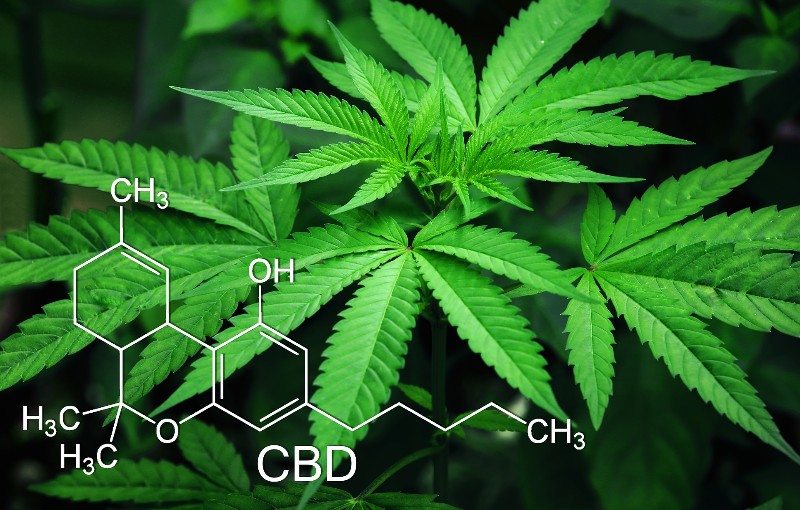CBD is one of many cannabinoid compounds derived from the cannabis plant. Also known as cannabidiol, CBD is non-psychoactive and frequently used for medical purposes as an anti-inflammatory and analgesic. It can be taken orally, smoked, or applied to the skin.
CBD is currently being studied by universities and federal agencies to determine its effectiveness as a medical treatment for a variety of ailments, including epilepsy, schizophrenia, diabetes, PTSD, depression, and chronic pain, among others.
It is important to note, limited scientific testing has been conducted on cannabis or its derivatives. The cannabis plant is still classified by the DEA as a Schedule I drug. Drugs in this category are labeled as having a high potential for abuse. This classification makes it difficult for researchers to perform thorough studies on CBD or any other cannabis compounds.
In this article, we’ll cover where a certain kind of CBD is legal in the US, two common uses for the compound, where to buy it, dosing, and side effects.
CBD Basics, Science, and Research
Dr. Mark Rosenfeld, CEO of ANANDA Scientific and Founder and Chief Scientist of Grant Life Sciences, explains the basics of CBD, how it’s viewed by science and our government, and how we should be thinking about it moving forward.
[embedyt] https://www.youtube.com/watch?v=AAMNyQI3NvA[/embedyt]
You can read the full interview with Dr. Rosenfeld here.
Where is CBD Legal in the US?
CBD derived from hemp is now legal anywhere in the U.S. thanks to the passage of the 2018 Farm Bill. Hemp is cannabis that contains less than .3 percent THC. CBD derived from cannabis with more than .3 percent THC is still federally illegal.
Cannabis with THC concentrations higher than .3 percent, and any CBD derived from it, is still classified as as Schedule I drug.
According to the Drug Enforcement Agency, it has “no currently accepted medical use and a high potential for abuse.” The exception to this rule is Epidiolex, an epilepsy treatment containing CBD. The CBD-based treatment was classified as a Schedule V substance by the FDA in June of 2018.
As noted in a DEA statement, “Marijuana and CBD derived from marijuana remain against the law, except for the limited circumstances that it has been determined there is a medically approved benefit. In those instances, such as here, the drug will be made appropriately available to the public for medical use.”
But while CBD is legal on the national level, Idaho, Nebraska, and South Dakota still have restrictions on all cannabis and cannabis-derived products. Considering the state-by-state regulation in the US, just make sure to know your state’s laws and do your best to determine whether or not the CBD you are looking to purchase was derived from hemp.
Two Common Uses for CBD: Anxiety and Pain Relief
More than 29 percent of Americans are affected by some type of anxiety disorder. CBD is becoming a popular treatment, largely due to clinical studies demonstrating its effectiveness in reducing anxiety in human test subjects.
Cannabidiol interacts with several endocannabinoid receptors known to regulate anxiety-related behaviors.
There are many neuropsychiatric disorders rooted in excessive fear and anxiety, including generalized anxiety disorder (GAD), panic disorder (PD), obsessive-compulsive disorder (OCD), and social anxiety disorder (SAD).
According to a study by the National Institutes of Health (NIH), “preclinical evidence supports systemic CBD as an acute treatment of GAD, SAD, PD, OCD, and PTSD…”
The NIH have also sponsored several preclinical studies concerning the use of cannabis for pain relief. Otherwise, there have been relatively few studies around CBD due to its federal classification as a Schedule I substance.
A pharmaceutical treatment known as nabiximol, trade name Sativex, is being used throughout most of Europe to treat the symptoms associated with multiple sclerosis.
Nabiximols are equal parts THC and CBD, the combination of which has been shown to be effective against central and peripheral neuropathic pain.
CBD’s anti-inflammatory properties likely contribute to the analgesic effects of nabiximols. This is only one instance of many in which found CBD in combination with THC offers the most comprehensive pain relief.
Where to Buy CBD Products
Now that it’s legal, CBD oil and related products can be purchased from a variety of online retailers and in most physical retail cannabis dispensaries. If possible, choose a source with seed-to-sale tracking software.
Retailers with seed-to-sale tracking can prove where their product originated, what went into it, what strain it’s derived from, and where it was ultimately distributed.
This information can be very important when using CBD as a medicine or in large quantities, as cannabis is often grown with pesticides or herbicides which may aggravate existing illnesses.
Additionally, seed-to-sale tracking will verify whether the CBD was sourced from a hemp plant (containing less than .3 percent THC) or from a cannabis plant.
Only purchase CBD from licensed retailers. You may also want to consider the following factors: concentration, taste, price, ease of use, and immediacy of effects.
First and foremost, you need to determine the potency and concentration of the CBD supplement you are ingesting. This information will help you determine proper dosing and ensure consistency in your experience.
The taste of the product may be an important factor for you if you will be ingesting the supplement orally or mixing it with food or beverages.
Price will also be an important consideration, depending on the length of time you would like to pursue CBD as a treatment. It may also be a factor when considering potency and dosing.
How you’ll be ingesting the substance will also play a major role in your experience. You want it to easy to use and consistent so you can clearly track your results. You may feel more comfortable with sublingual drops than with a vaporizer.
How you choose to ingest the substance will make an impact on your overall experience.
Lastly, decide how quickly you want to feel the effects of the CBD. Quick activation or slow, lasting effects may require different methods of ingestion, or possibly different CBD concentrations.
CBD Oil Dosage: How Much Should You Take?
There are no consistent dosing formulas for CBD. The amount an individual should take will vary based on the concentration of CBD, how much the person weighs, their body chemistry, and the severity of their condition.
Further, each person’s physiology and brain chemistry can change throughout their lifetime, meaning what was once an effective dose may no longer produce a result.
It is always best to start with the lowest possible dose and slowly increase the amount until achieving the desired result. Another way to estimate your dosage is to take between one and six milligrams of CBD for every 10 pounds of body weight.
For example, someone in severe pain who weighs 150 pounds might take 18 milligrams of CBD, while someone with mild pain who weighs 150 pounds might take 12 milligrams of CBD.
But what does 18 milligrams of CBD look like? You have to first determine the serving size for your CBD oil. Then you need to find how many milligrams that serving size contains. Next, determine a reasonable starting dosage based on your weight and pain level.
Your last step is to calculate your dosage based on how much CBD is contained in each drop of oil. For step-by-step calculations, check out this helpful sample from Honest Marijuana.
Studies performed with animals have shown a bell-shaped dose-response curve, with beneficial effects observed at moderate but not higher doses of CBD.
As with most cannabis-related products, it is best to start your dose low and slowly increase until therapeutic effects are achieved.
What Are the Side Effects of CBD?
Though few studies have been conducted using pure CBD, those that exist suggest very few side effects in human trials. Of the few reported, the most common are fatigue, appetite decrease or increase, and weight loss or gain.
Several studies sponsored by the NIH have concluded that CBD has a favorable safety profile with limited side effects.
Author
-

Patricia Miller is an executive editor at Innovative Properties Worldwide. She explores science, technology, and policy shaping the legal cannabis sector. Follow her work when you subscribe to Cannabis & Tech Today at cannatechtoday.com/subscribe/ or visit her website https://patriciamiller.squarespace.com/.






